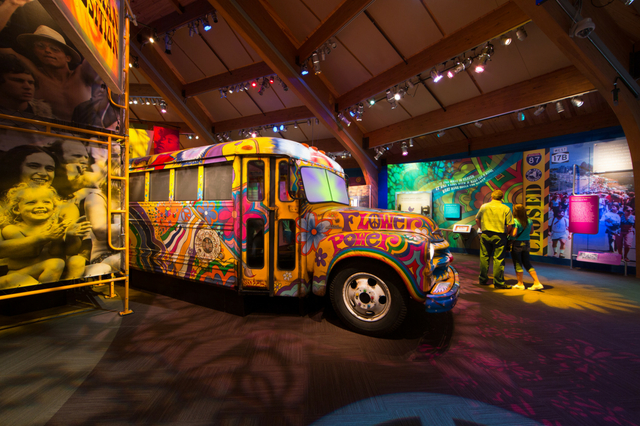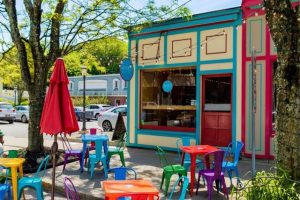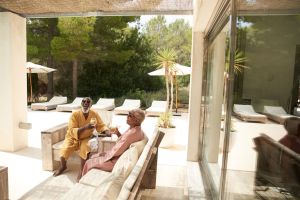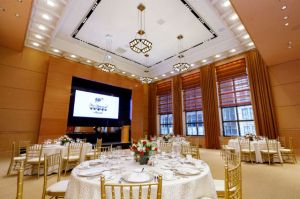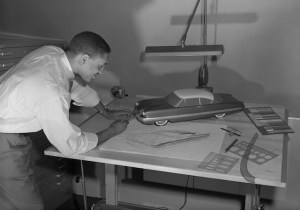In August 1969, over 400,000 people descended on an alfalfa field on Max Yasgur’s farm in Bethel, N.Y., for what was advertised as “An Aquarian Exposition: 3 Days of Peace & Music.” Nearly a half-century later, the vibe from this generation-defining event, better known as Woodstock, still resonates in this Catskills town.
Bethel Woods Center for the Arts, located on the land where the festival took place, continues the magic of Woodstock with live performances, a museum showcasing the 1960s, and other cultural and educational events.
At the National Register Historic Site, visitors can stand in the footprint of the stage or relax in the festival field, where you can almost hear Jimi Hendrick’s version of “The Star-Spangled Banner” reverberating through time. Later this summer, the first trail of the restored Bindy Bazaar area that served as the marketplace at Woodstock will open to the public.
For those who were there to experience Woodstock and want to relive the memories or folks who simply would like to get a sense of where it all happened, Bethel Woods is a cultural destination like no other.
Preserving History Through Music
This unique place and its legacy is protected by staying true to its roots in music. No matter what kind of tunes you’re into – rock, country, pop, jazz, classical or folk – Bethel Woods is a memorable place to see live performances.
The Pavilion amphitheater at Bethel Woods Center for the Arts opened in 2006 and has since hosted numerous well-known performers, including Bob Dylan, Elton John, the New York Philharmonic, The Eagles and The Zac Brown Band.
Click here for a full list of performers and events.
Experience the ’60s
Visitors to Bethel Woods can immerse themselves in the social, political and cultural vibe of the 1960s at The Museum at Bethel Woods. For those old enough to remember the era, the videos, personal stories and artifacts bring back the feelings from the Summer of Love. For younger generations, the museum both entertains and educates about the significance of the Woodstock festival taking place at the end of a decade filled with cultural change.
The permanent collection takes visitors on a journey through time, back through the struggles and idealism of the 1960s. Informative, interactive displays explain the changes that occurred throughout the decade, from the initial middle-class prosperity of the 1950s to the Cold War and the assassinations of President John F. Kennedy and Martin Luther King Jr. Video footage and photographs tell the story of the civil rights movement and the U.S. involvement in Vietnam, two of the defining pressures that led to the call for peace, brotherhood and love that culminated in the Woodstock festival.
Images of the crowds filling Yasgur’s hallowed field, just down the hill from the Museum, cover the multihued walls. One can even take a seat on the psychedelic bus, decorated with whorls of bright colors and beaded curtains over the windows, and pretend it’s August 1969 again.
Complementing its extensive and growing permanent collection, the Museum also hosts special exhibits each year. These temporary shows range from artists such as Peter Max, who influenced social change in the ’60s, to a photography exposition of civil rights leaders from the era, to sculpture spread across the historic grounds. Two fast-approaching milestone anniversaries will be commemorated with special shows: the 1968 U.S. elections and, of course, the 50th anniversary of Woodstock in 2019.

Educational Immersion
Bethel Woods has continued to develop educational initiatives and events to further its mission to be the premier ’60s cultural and educational center. A major goal is to educate the public about the lessons the 1960s imparted and how society can maintain its engagement with peaceful change. To meet this goal, the center offers a multidisciplinary arts program, through which the spirit of the Woodstock era is shared with upcoming generations.
The weekly Saturdays at the Woods program encourages parents and children to work together to develop artistic and self-expression skills. A more structured program, Explore the ’60s, teaches schoolchildren about the importance and lasting effects of the decade through a reading, writing and speaking curriculum that meets several Common Core state standards objectives. A program designed specifically for high school students, Project: Identity, combines art instruction with the development of imagination and innovation skills to help teens transition and help them realize the importance of the arts to a well-rounded life.
Festivals
Bethel Woods hosts several festivals throughout the year, providing an opportunity for visitors to gather and celebrate the bounty of the Catskills region. The Harvest Festival, which has been held for two decades, occurs every Sunday in September. This family-friendly event features farmers markets, artisans and crafters, live performances, a sit-down farm-to-table brunch and kids’ activities.
The Bethel Woods Wine Festival and CRAFT: Beer, Spirits, and Food Festival, both held in October during the peak foliage splendor, showcase the best of the region’s vintners, brewers, distillers, and food producers. Rounding out the year, the Holiday Market brings together local artisans offering a wide variety of gifts from New York state.
Baron Wolman, a photographer best known for his candid portraits of musicians for “Rolling Stone,” described the importance of the 1969 festival: “Woodstock showed the world how things could have been, and for this reason it’s important that we never forget this experience, this place, this time, this dream that came true … if only for three days.”
Today, nearly 50 years later, this seminal moment in U.S. history is preserved for generations to come, and the ideas and lessons from that time, nearly 50 years ago, will not be forgotten.
Learn more about Bethel Woods Center for the Arts and start planning your visit today.



